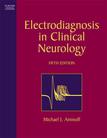临床神经病电诊法
2005-3
Elsevier Science Health Science div
Aminoff MD DSc FRCP, Michael J.
859
The New Edition of this respected reference delivers complete, practical guidance on current electrodiagnostic techniques and their clinical applications for investigating problems of both the central and peripheral nervous systems. Completely revised and updated, this 5th Edition provides state-of-the-art knowledge on electroencephalography, electromyography, nerve conduction studies, evoked potentials, polysomnography, and electronystagmography. Emphasizes the clinical applications of each electrodiagnostic technique, providing state-of-the-art guidance for both non-specialists and specialists. Discusses the principles, scope, limitations, diagnostic importance, prognostic relevance, and complications for each technique. Clarifies the technical and practical aspects of electrodiagnostic tests with over 700 charts, figures, and tables. Includes a new chapter on Magnetoencephalography that discusses the use of this newer modality for the evaluation of patients with disorders such as epilepsy. Provides a new chapter on Quantitative Electromyography as well as a new chapter on Neurophysiological Evaluation of Sacral Function that includes new discussions of how to evaluate bladder, bowel, and sexual function. Features revisions and updates to all other existing chapters.
Michael J. Aminoff, MD, DSc, FRCP, Professor of Neurology, University of California, San Francisco, School of Medicine, San Francisco, CA; Attending Physician and Director of the Clinical Neurophysiology Laboratories, UCSF Medical Center, San Francisco, CA
SECTION Ⅰ INTRODUCTION 1 The emergence of Electrophysiology as an Aid to Neurology 2 Electrophysiologic Equipment and Electrical SafetySECTION Ⅱ ELECTROENCEPHALOGRAPHY AND MAGNETOENCEPHALOGRAPHY 3 Electroencephalography: General Principles and Clinical Applications 4 Neonatal and pediatric Electroencephalography 5 Long-Term Monitoring for Epilepsy 6 Ambulatory Electroencephalographic Monitoring 7 Invasive Clinical Neurophysiology in Epilepsy and Movement Disorders 8 Topographyic Mapping, Frequency Analysis, and Other Digital Techniques in Electroencephalography 9 Intraoperative Electroencephalographic Monitoring During Carotid Endarterectomy and Cardiac Surgery 10 magnetoencephalographySECTION Ⅲ ELECTROMVOGRAPHY, NERVE CONDUCTION STUDIES, AND RELATED TECHNIQUES 11 Clinical Electromyography 12 Quantitative Electromyography 13 Nerve Conduction Sutdies 14 Microneurography as a Clinical Research Tool 15 Electrophysiologic Sutdy of Disorders of Nuromuscular Transmission 16 h-Reflex and F-Response Studies 17 The Blink Reflex 18 Electrophysiologic Evaluation of Movement Disorders 19 Evaluation of the Autonomic Nervous SystemSECTION Ⅳ EVOKED POTENTIALS AND RELATED TECHNIQUES PETER GOURAS 20 Electroretinography 21 Visual Evoked Potentials in Clinical Neurology……SECTION Ⅴ TESTING OF VESTIBULAR FUNCTIONSECTION Ⅵ ELECTROPHYSIOLOGIC EVALUATION IN SPECIALS SITUATIONSIndex
REVIEW OF THE LAST EDITION: "A standard neurology textbook that has stood the test of time....Currently the best textbook value on the market....The standard toward which all other single volume electrodiagnostic textbooks will need to strive."-Pediatric NeurologyEach chapter provides background to the technique, its principles, scope, limitations, diagnostic importance, prognastic relevance, and possible complications, with many tables and charts included for illustration.SciTech Book News, September 2005
